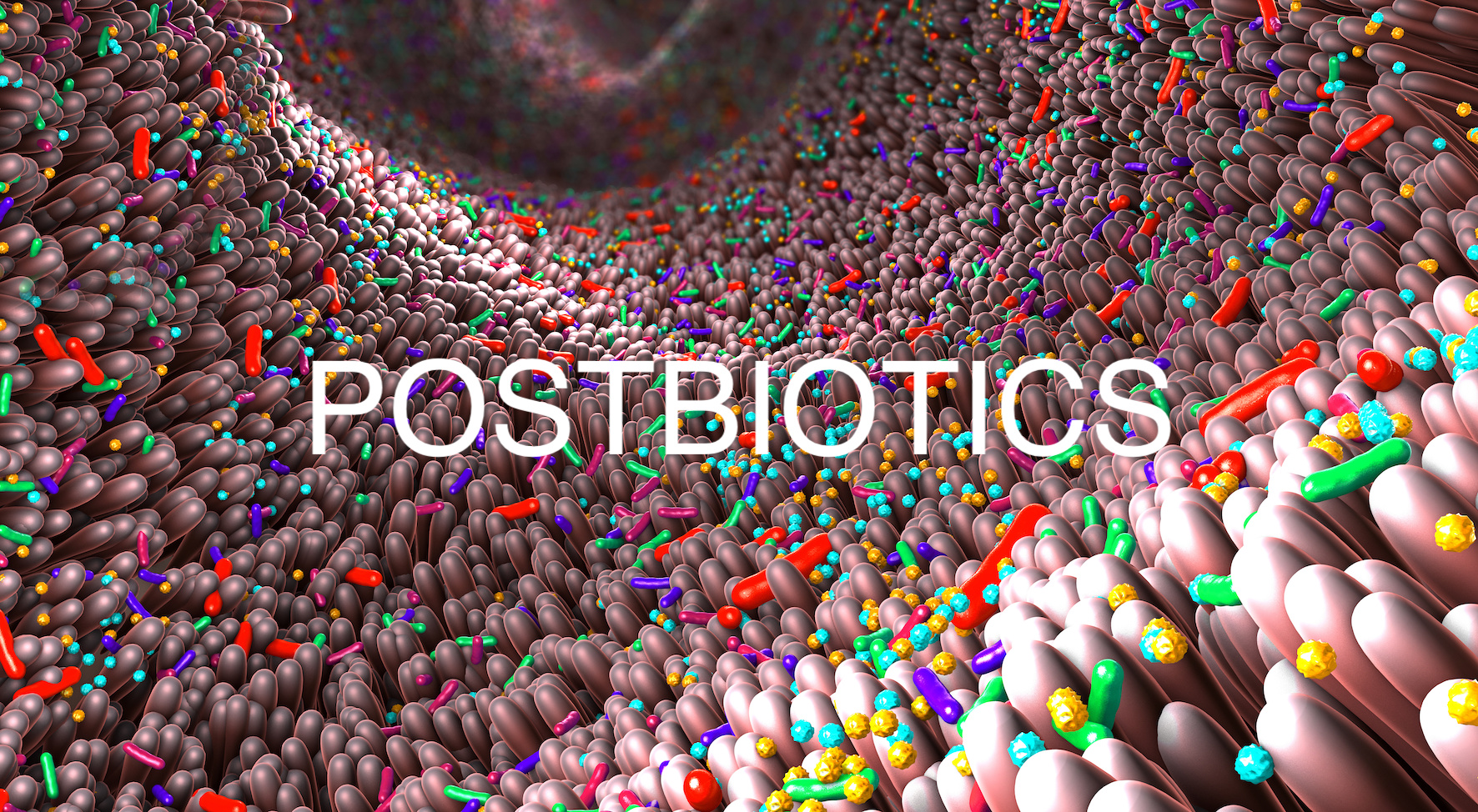By Frederique Respondek, PhD
According to Lumina Intelligence*, there is a huge increase of interest towards “postbiotic” and their associated health benefits with an increase of 1300% in Google search between 2019 and 2021; where do we stand from a scientific point of view ?
*Postbiotics search 1,300% increase in Google searches (nutraingredients.com)
First , while the term was already used as well with others like “paraprobiotics”, “ghost probiotics”… experts from ISAPP published a paper in Nature this year where they defined “postbiotic as a preparation of inanimate microorganisms and/or their components that confers a health benefit on the host”[1]. It means that postbiotics can be heat-treated bacteria or yeast, their lysates and /or their metabolites. It is different from traditional fermented foods in a sense that the microorganisms must be characterized and inactivation has occurred. They also exclude purified metabolites from the scope of postbiotic in the absence of cellular biomass. For example, purified butyrate would not be considered in this definition.

Postbiotic does not have to be derived from a probiotic for the inactivated form to be accepted as a postbiotic.
As for the use of probiotics, Lactobacillus and Bifidobacterium-based postbiotics are the most studied so far and most used in foods and beverages. However several other strains have been recently evaluated by EFSA like Yarrowia lipolytica,Mycobacteriummanresensis and Akkermansia muciniphila. Yarrowia lipolytica yeast heat-killed biomass as well as a chromium- and a selenium-enriched form have been authorized as a Novel Food for foods supplements under specific conditions of use (See Table 1). While Mycobacteriummanresensis has been considered safe by EFSA in 2019 [2], the product is not yet authorized as its conditions of use might not be considered relevant for food supplements by several Member States. Very recently pasteurized Akkermansia muciniphila has also been considered safe by EFSA (2021) [3] to be used in food supplements for adults excluding pregnant and lactating women, and in foods for special medical purposes at the dose of 3.4 x 1010 cells/day (<10 CFU/g of live cells). It will have to be authorized by European Commission before entrance into EU market.
| Strain | Food categories | Max level | Food labelling |
| Yarrowia lipolyticayeast heat-killed biomass | Food supplements, excluding those for infants and young children | 6g/day for children <10 years of age, adolescents & general population3g/day for children (3-9 years) | Yarrowia lipolytica yeast heat-killed biomass |
| Chromium-containing Yarrowia lipolytica yeast heat-killed biomass | Food supplements, excluding those for infants and young children | 4 g/day for children from 10 years of age, adolescents and adults, resulting in 92μg of chromium per day2g/day for children (3-9 years) | Chromium-containing yeast (Yarrowia lipolytica)biomass |
| Selenium-containing Yarrowia lipolytica yeast heat-killed biomass | Food supplements, excluding those for infants and children under 4 years of age | 800mg/day for adults, resulting in 160µg of Se per day500mg/day for adolescents (11-17 years) 100mg/day for children (7-10 years) 50mg/day for children (4-6 years) | Selenium-containing yeast (Yarrowia lipolytica)biomass |
Clinical evidence in Humans starts to accumulate
Besides extensive scientific literature on in-vitro and in-vivo models [4], clinical evidence in humans starts to accumulate on immunomodulating effects, protection against pathogens, as well as management of digestive and metabolic disorders (Table 2).
| Nature of postbiotics | Study population | Main outcomes | References |
|---|---|---|---|
| Gut health | |||
| Heat-inactivated Bifidobacterium bifidum MIMBb75 | Adults with IBS; n=443 | Reduction of gut symptoms and pain | Andresen et al. 2020. Lancet |
| Saccharomyces cerevisiae fermentate | Adults with constipation; n=8 | Improvement of stool consistency and trend for higher stool frequency | Pinheiro et al. 2017 |
| Inactivated Lactobacillus acidophilus LB | Adults with IBS; n=297 | Lower frequency of diarrhoea and better quality of life | Tarreira et al. 2011. Dig Dis |
| Inactivated Lactobacillus acidophilus LB | Adults with chronic diarrhoea; n=137 | Lower frequency of diarrhoea | Xiao et al. 2003. Adv Ther. |
| Inactivated Lactobacillus acidophilus | Adults; n=120 | Reduction of Helicobacter pylori | Canducci et al. 2000. Aliment Pharmacol. Ther. |
| Immune Response | |||
| Heat-killed pediococcus acidilactici K15 | Children (3-6 years); n=172 | Higher salivary IgA | Hishiki et al. 2020. Nutrients |
| Preparation of Mycobacterium manresensis | Adults with / without tuberculosis; n=51 | Stimulation of T cell mediated response | Montane et al. 2017. PLoS ONE |
| Heat-killed Lactobacillus kunkeei from honeybee products | Healthy Adults; n=11 | Increased secretory IgA concentrations and secretion in saliva | Asama et al. 2015. |
| Saccharomyces cerevisiae fermentate | Non vaccinated adults; n=116 | Reduced incidence of colds and flu-like symptoms | Moyad et al. 2010 |
| Metabolism | |||
| Heat-killed Lactobacillus plantarum L-137 | Overweight healthy adults; n=100 | Lower blood total and LDL cholesterol | Tanaka et al. 2020. Eur J Nutr |
| Heat-inactivated Bifidobacterium animalis CECT 8145 | Adults with abdominal obesity; n=135 | Reduced waist circumference and improved body mass index | Pedret et al. 2019. Int J Obes (London) |
| Pasteurized Akkermansia muciniphila | Overweight/obeseinsulin resistant adults; n=40 | Improvement of insulin sensitivity, reduced insulinemia and plasma total cholesterol. Trend to reduce body weight, fat mass and hip circumference | Depommier et al. 2019. Nat Med |
| Heat-killed Pediococcus pentosaceau LP28 | Overweight adults; n=62 | Reduce BMI, body fat mass and waist circumference | Higashikawa et al. 2016. Eur J Clin Nutr |
Various modes of action
According to ISAPP experts panel again, there are five possible mechanisms of action to explain effects of postbiotics on health:
- Modulation of gut microbiota
- Enhancement of gut barrier function
- Modulation of immune response (local, systemic)
- Modulation of metabolism
- Signalling to nervous system
Dead and live microbes share common activities like interference with pathogen attachment and enhancement of epithelial barrier in the gut. Interestingly in the field of modulation of metabolism, inactivated bacteria seem more efficient than their live counterpart. More particularly, inactivated Pedicoccoccus pentosaceus LP28, Bifidobacterium animalis CECT 8145, Pasteurized Akkermansia muciniphila were more efficient than the live microorganisms to reduce body fat mass and waist circumference in overweight adults after 3 months of dietary supplementation [5-7]. Additional preclinical study on pasteurized Akkermansia muciniphila suggested that this effect might be related to a reduction of intestinal carbohydrates absorption and enhanced intestinal epithelial turnover leading to higher energy excreted into faeces [8].
Postbiotic preparations can be used in many food and beverages products because they are much more stable than probiotics (live microorganisms) and are efficient at low dose in comparison to fibres for example.
Scientific references :
1. Salminen, S., et al., The International Scientific Association of Probiotics and Prebiotics (ISAPP) consensus statement on the definition and scope of postbiotics. Nat Rev Gastroenterol Hepatol, 2021. 18(9): p. 649-667.
2. EFSA, Safety of Yarrowia lipolytica yeast biomass as a novel food pursuant to Regulation (EU) 2015/2283.Efsa j, 2019. 17(2): p. e05594.
3. EFSA, Safety of Pasteurized Akkermansia muciniphila as a novel food pursuant to Regulation (EU) 2015/2283. Efsa j, 2021. 19(9).
4. Piqué, N., M. Berlanga, and D. Miñana-Galbis, Health Benefits of Heat-Killed (Tyndallized) Probiotics: An Overview. Int J Mol Sci, 2019. 20(10).
5. Depommier, C., et al., Supplementation with Akkermansia muciniphila in overweight and obese human volunteers: a proof-of-concept exploratory study. Nat Med, 2019. 25(7): p. 1096-1103.
6. Higashikawa, F., et al., Antiobesity effect of Pediococcus pentosaceus LP28 on overweight subjects: a randomized, double-blind, placebo-controlled clinical trial. Eur J Clin Nutr, 2016. 70(5): p. 582-7.
7. Pedret, A., et al., Effects of daily consumption of the probiotic Bifidobacterium animalis subsp. lactis CECT 8145 on anthropometric adiposity biomarkers in abdominally obese subjects: a randomized controlled trial. Int J Obes (Lond), 2019. 43(9): p. 1863-1868.
8. Depommier, C., et al., Pasteurized Akkermansia muciniphila increases whole-body energy expenditure and fecal energy excretion in diet-induced obese mice. Gut Microbes, 2020. 11(5): p. 1231-1245.
Author : Frederique Respondek, PhD




No comments! Be the first commenter?